
I’ve been trying more recipes from Shizuo Tsuji’s great “Japanese Cooking: A Simple Art”. Since I had some left-over dashi, I decided to make two dishes that require dashi. I am not sure if this would be served together in Japan, but it did taste well together and I was well pleased with the result. I pre-cooked the chicken sous-vide for an easier way to get chicken that is cooked through (and pasteurized) as well as juicy, but the original recipe doesn’t require that so you can also make this without sous-vide equipment.
The recipes make use of light Japanese soy sauce. The main difference with regular Japanese soy sauce is that it is saltier and has less color. You can substitute with regular Japanese soy sauce, but might need to add some salt.
Deep-fried marinated chicken
225 grams (1/2 pound) boneless and skinless chicken thigh
2 Tbsp saké
1 Tbsp light Japanese soy sauce
1 tsp fresh ginger juice
2 tsp very finely chopped green onion
oil for frying
flour for frying (I used special Italian flour for deep-frying which is 30% rice flour to make it less greasy, but regular flour will do)
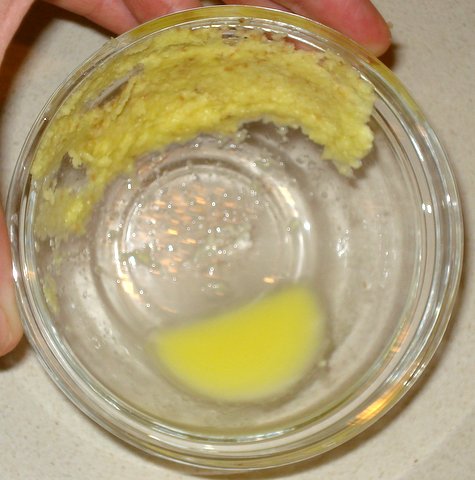
Make the fresh ginger juice by grating a piece of ginger and pressing out the juice with the back of a spoon.
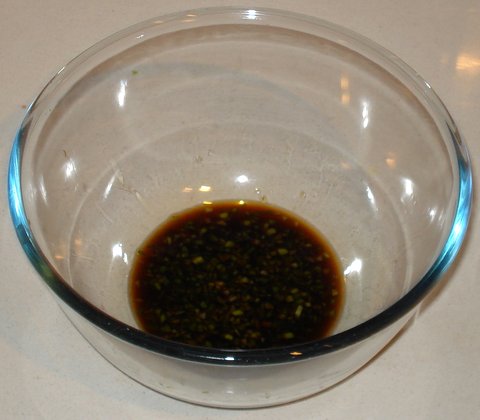
Mix the soy sauce, saké, ginger juice, and green onion in a bowl.
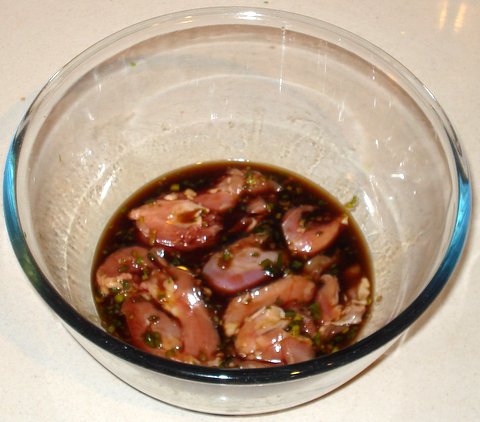
If not cooking sous-vide, cut the chicken into bite-size pieces. Otherwise, cut each thigh in two only. Put the chicken into the marinade and mix to coat.

Marinate for 30 minutes, or cook sous-vide for 2 hours at 64.5C/148F in a ziploc sous-vide pouch (with the air removed by using the water displacement method).
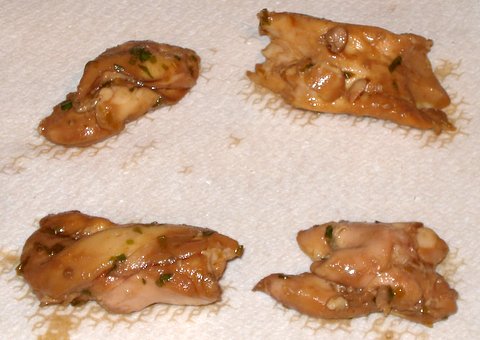
After marinating or sous-vide cooking, drain from marinade and pat dry with paper towels.

Coat each piece of chicken with flour, and let the coated chicken rest for a few minutes.
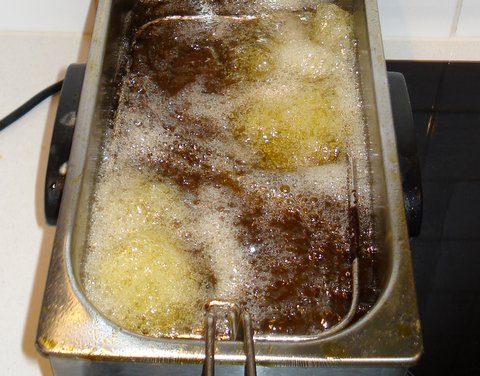
When pre-cooked sous-vide, deep-fry in very hot oil (190C/375F) until golden. The chicken is ready as soon as the outside looks right, because it is already cooked through.
When marinated only, deep-fry in moderately hot oil (170C/340F). Since the chicken pieces are smaller and the oil temperature is lower, the chicken should still be cooked through as soon as the outside looks right, but test a piece to make sure.
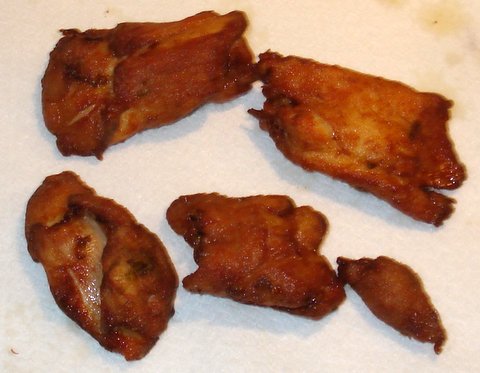
Put the deep-fried chicken on paper towels to drain excess oil. The chicken is now ready to be served.

If you pre-cooked the chicken sous-vide so you left the chicken pieces large and you’d like to eat with chop sticks, you could slice the chicken to make it easier to eat. Just make sure that you present the chicken more nicely than I did in the picture above…
Drenched Daikon
about 20 cm (8″) of a giant white radish (daikon or rettich)
1 1/4 cup dashi
1/2 tsp salt
1 tsp light soy sauce
1 Tbsp mirin

Peel the radish and cut into 2.5 cm (1″) slices.

‘Bevel’ the edges to make the rounds look more interesting.

Put the daikon slices in a pot of lightly salted water. Bring to a boil.
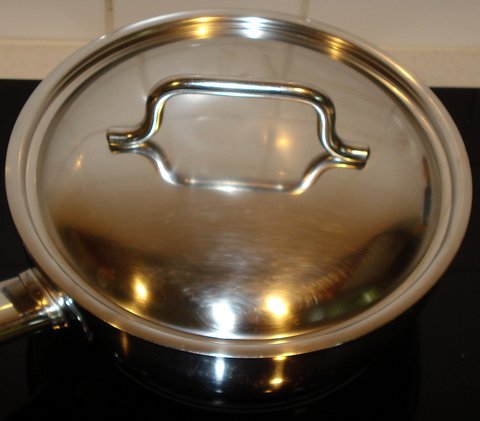
Boil, covered, for 40 minutes or until the daikon becomes slightly translucent. Drain.
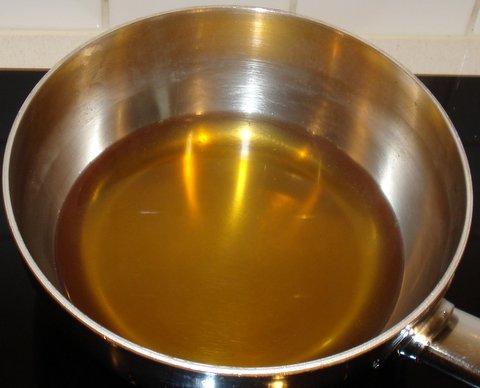
Combine the dashi, soy sauce, mirin and salt in a pot.
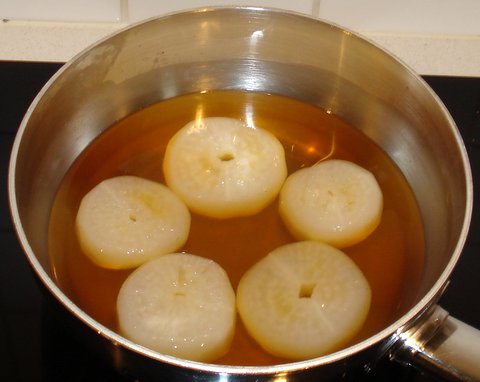
Add daikon and bring to a simmer (not boiling). Cover and let simmer for 30 minutes.
Tsuji insists on using a drop-lid or circle of baking paper with a vent, but I don’t think the reasons he gives for doing so (keep the daikon submerged, prevent the daikon from being damaged during cooking) actually apply. So I didn’t bother (also since I don’t have a wooden drop-lid).
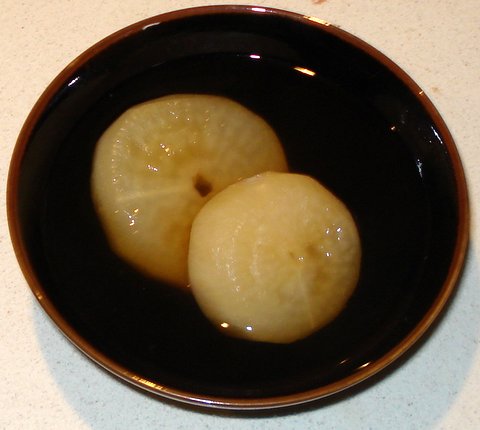
Serve daikon slices in a bowl with some of the simmering liquid. Tsuji says to garnish with a kinome sprig. By all means do so if you can find any 😉
Noodles in Broth
For 2 servings
180 grams udon or soba noodles
chopped green onion as a garnish
2 cups dashi
1/2 tsp salt
1 Tbsp dark Japanese soy sauce
1 Tbsp light Japanese soy sauce
1 tsp sugar
1 Tbsp mirin
shichimi toragashi

Boil the noodles according to package instructions in plain water (no salt).

Drain and rinse well with cold water to remove the starch.
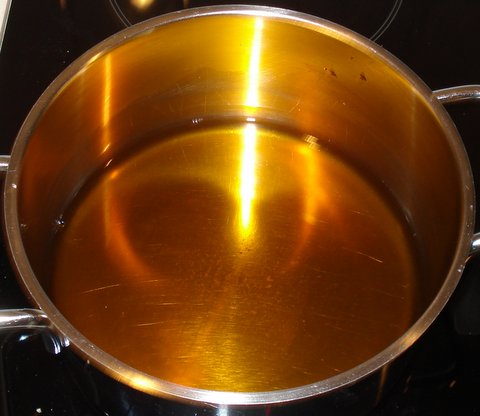
Combine dashi with salt, dark soy sauce, light soy sauce, sugar, and mirin. Bring just to the boiling point and keep simmering until ready to serve.
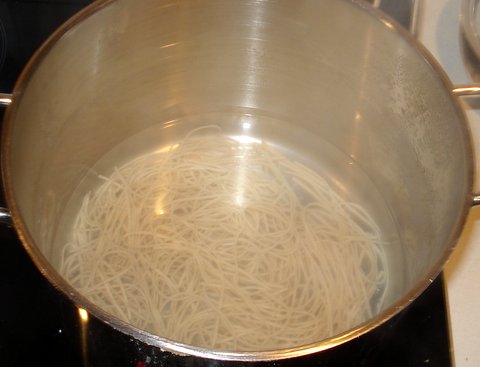
Reheat the noodles in hot water (30 seconds is enough).
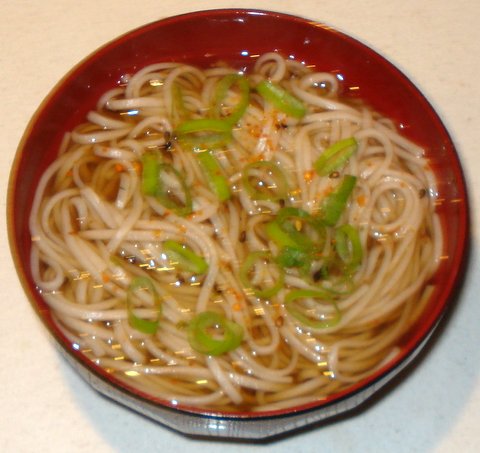
Put noodles in a bowl. Add dashi and garnish with green onions and shichimi toragashi to taste.

To serve everything hot at the same time, prepare the noodles up to the point where they need to be reheated while the daikon is simmering. Deep-fry the chicken, and while the chicken is frying reheat the noodles and put the daikon and noodles into bowls. Serve everything as soon as the chicken is ready.

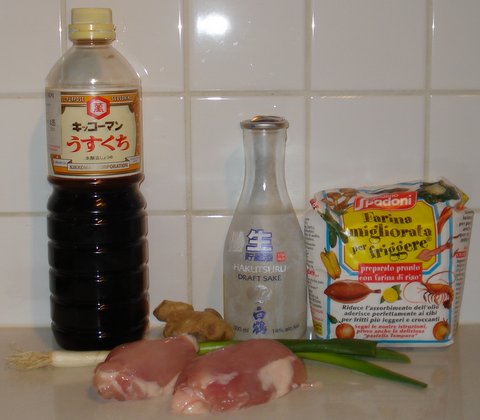
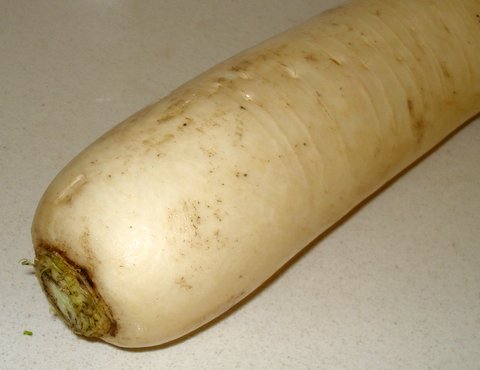

The perfect meal! I need to get this cookbook!
LikeLike
Masterful attention to detail. I love the edge-rounding. What does the daikon taste like. I have seen them in the oriental market but have never thought to cook them.
Best,
Conor
LikeLike
Raw daikon tastes like radish. Cooked the flavor is mild, that’s why it’s simmered to acquire more taste. This is the only recipe for cooked daikon in the book. It is often eaten raw and grated, as garnish with sashimi or in warm tempura dipping sauce (see my recent tempura post).
LikeLike
I never cook japanese but that chicken looks great.
LikeLike
Give it a try, the chicken is very easy!
LikeLike
Mmm. I like Italian food, but I LOVE Japanese food. 🙂
LikeLike
I love both, but by now it feels like Italian is my own familiar food that I am confident about, whereas Japanese is exotic and I’m not sure whether I’m doing it right.
LikeLike
Great presentation/dishes – looks like restaurant-grade!
LikeLike
Thanks!
LikeLike
Looks great…we are enjoying the latest series of the Japan-inspired recipes…
LikeLike
Thanks! I’m enjoying it too, so more to come!
LikeLike
Great Daikon recipe… and everything is beautifully plated!
LikeLike
Thanks. The visual presentation is very important in Japanese cuisine.
LikeLike
Perhaps more so than in any other, in my experience 🙂
LikeLike
I agree!
LikeLike
awesome work, stefan. all of your japanese recipes look awesome. honestly, i expected nothing less.
i love the color on your fried chicken. i was wondering, have you ever tried using katakuriko (or potato starch) instead of flour? it cooks a little bit differently, and the texture is out of this world. while some people prefer flour, i think it is totally worth giving a try once or twice to see how you feel about it.
also, i love the natural spiciness of daikon. personally, despite it being the cheapest part of a lot of meals, i think it has the best texture and most honest flavor.
LikeLike
Thanks, Misha, for checking out my Japanese recipes and leaving such thoughtful comments. I have used corn starch (rather than potato starch), and the texture was definitely out of this world. https://stefangourmet.com/2012/12/16/crispy-deep-fried-chicken/
I really like daikon in tempura sauce. I couldn’t believe how good tempura sauce was when I made it with dashi from scratch for the first time.
https://stefangourmet.com/2012/07/27/tempura/
LikeLike